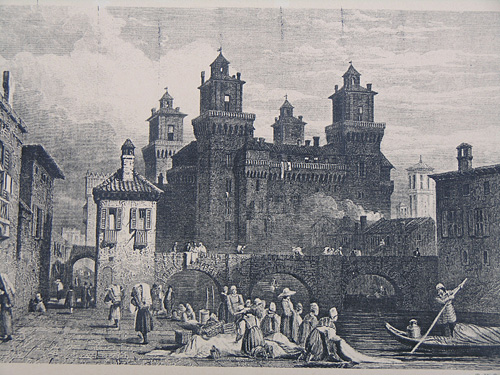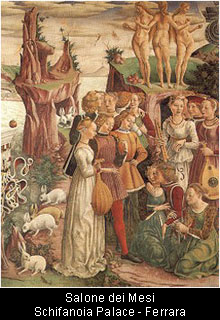 The splendind fresco cycles in the hall of the months at Palazzo Schifanoia fulfiled for Duke Borso d'Este circa 1470, shows how music was important at court in that period.
Ferrara during the '400s and '500s was one of the most important cities for music.
The splendind fresco cycles in the hall of the months at Palazzo Schifanoia fulfiled for Duke Borso d'Este circa 1470, shows how music was important at court in that period.
Ferrara during the '400s and '500s was one of the most important cities for music.
The city was host to some of the greatest musicians of the era: Guillaume Dufay, Josquin Desprez, Antoine Brumel, Jacob Obrecht, Adrian Willeart, the Dalla Viola brothers, Nicola Vicentino, Cipriano De Rore...etc.
In the Duke's Palace there were two music halls with the adjacent instrument room that were to always be perfectly tuned, ready to be used in any occasion: harps, lutes, drone lyres, contratreble and tenor bass violas, violas, guitars, rebecks, bass violas, harpsicords, and many wind and percussion instruments, adjacent to the Duchess' garden was the violin-maker's workshop.
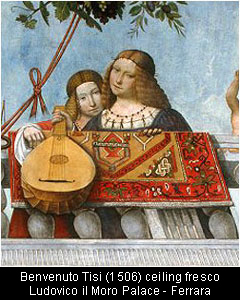 The reinstatment of a harpsicord bought in Venice because the Duke did not like it shows how much Ercole I d'Este understood about instruments. There are many purchasing documents, a very interesting one is doc. 945, in 1511 two marquis lire are given as advance payment to buy 30 pounds (about 11 Kg) of lead and a bag of carbon to build an organ.
The reinstatment of a harpsicord bought in Venice because the Duke did not like it shows how much Ercole I d'Este understood about instruments. There are many purchasing documents, a very interesting one is doc. 945, in 1511 two marquis lire are given as advance payment to buy 30 pounds (about 11 Kg) of lead and a bag of carbon to build an organ.
We also find a document from 1500 in which Antonio Goretto, an amateur musician, formed a large collection of string instruments.
Among the violin-makers of this ear we should remember: Pietrobono del Chitarrino, Polverino Rinaldo, Guarino Battista, Fontana Giovanni, Di Calabri Pier Vittorio, Gamberini Giovanni Lodovico, Marco degli Instumenti, Pazzaglia Francesco, Alfonso Cipri.
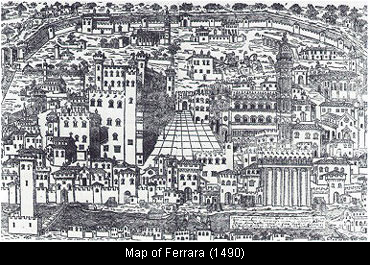 The Estense era in Ferrara came to an end in 1598, the years in which the city is develutionised by the Papal State. A strong musical crisis began at this time up to the point that after a few years the city lost Girolamo Frescobaldi to Rome.
The Estense era in Ferrara came to an end in 1598, the years in which the city is develutionised by the Papal State. A strong musical crisis began at this time up to the point that after a few years the city lost Girolamo Frescobaldi to Rome.
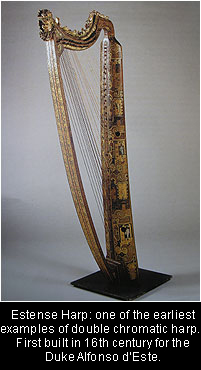 Notwithstanding this (including earthquakes and plagues) the strong violin-making tradition continued to produce great violin-makers: G. Battista Grancino, Alessandro Mezzardi, Giovanni Viorillo, Antonio Domenichelli, all good violin-makers, but there were even famous violin-makers such as Luigi Marconcini who was student to Omobono Stradivari, as well as Stradivari's sons and students Giuseppe (also a student of Storioni in Milan) and Gaetano and thier student's Luigi Marconi, Luigi Meletti and Alberto Battioni; the list goes on from the late 19th century with Luigi Soffritti (student to Meletti and awesome violin-maker) to the XX century with the brilliant Ettore Soffritti (student to his father), Anselmo Giotti, Gaetano Pareschi, Enrico Orselli and Ernest Pevere and all their students: Boscoli, Ferrari, Donati, Melloni, Felloni, Ungarelli, Marchi Tunioli.
Notwithstanding this (including earthquakes and plagues) the strong violin-making tradition continued to produce great violin-makers: G. Battista Grancino, Alessandro Mezzardi, Giovanni Viorillo, Antonio Domenichelli, all good violin-makers, but there were even famous violin-makers such as Luigi Marconcini who was student to Omobono Stradivari, as well as Stradivari's sons and students Giuseppe (also a student of Storioni in Milan) and Gaetano and thier student's Luigi Marconi, Luigi Meletti and Alberto Battioni; the list goes on from the late 19th century with Luigi Soffritti (student to Meletti and awesome violin-maker) to the XX century with the brilliant Ettore Soffritti (student to his father), Anselmo Giotti, Gaetano Pareschi, Enrico Orselli and Ernest Pevere and all their students: Boscoli, Ferrari, Donati, Melloni, Felloni, Ungarelli, Marchi Tunioli.
Importance covers the Cento Pievese in the province of Ferrara where the Carletti and later the Mozzani families are found as well as their teachings that gave life to numerous and skilful violin-makers. All the instruments built in Ferrara in these centruies are found in orchrestras, museums, privatecollections, scattered around the world and are in great demand.
Copyright © by Sergio Scaramelli

